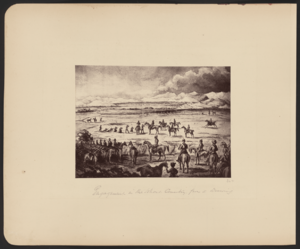Kurram Valley Field Force facts for kids

The Kurram Valley Field Force was a group of soldiers from the British and Indian armies. They were part of the Second Anglo-Afghan War, which took place from 1878 to 1879. This force was one of three main groups sent by the British to enter Afghanistan at the start of the war.
The Kurram Valley Field Force was led by Major General Frederick Roberts. It was the smallest of the three groups, with about 6,665 soldiers and 18 cannons. On November 21, 1878, Roberts' force crossed into Afghanistan from India. They moved through the Kurram Valley towards Kabul.
Contents
The War Begins
The Kurram Valley Field Force faced Afghan soldiers and local tribes. They fought and won an important battle called the battle of Peiwar Kotal on December 2, 1878. After this victory, they had a few smaller fights. Soon, Roberts' force took control of the entire Kurram Valley. More soldiers, about 3,500 men, joined the Kurram Field Force. Many of these new troops helped protect the supply routes back to India.
Peace and New Battles
The Afghan government soon asked for peace. The first part of the Afghan War ended in May 1879 with the Treaty of Gandamak. However, on September 3, 1879, a British official and his team were killed in Kabul. This event started the second part of the war.
At that time, the Kurram Valley Field Force was the only British group still in Afghanistan. They quickly received more soldiers from India. This larger group was then renamed the Kabul Field Force. General Roberts remained in command. His new mission was to advance on Kabul. The goal was to punish those responsible for killing the British official. The remaining soldiers in the Kurram Valley then became support troops for the Kabul Force. Brigadier General T. Gordon took over their command on September 27, 1879.
Who Was in the Force?
When the Kurram Valley Field Force entered Afghanistan on November 21, 1878, it had 5,335 officers and soldiers with 13 cannons. Here are some of the units that were part of this force:
British Army Units
- F Battery, A Brigade, Royal Horse Artillery (6 cannons)
- G Battery, 3rd Brigade, Royal Artillery (3 cannons)
- One squadron, 10th Hussars (a cavalry unit)
- 2nd battalion, 8th King's Regiment
- 72nd Highlanders (half of a battalion)
In total, there were 1,345 British officers and soldiers with 9 cannons.
Indian Army Units
- No. 1 Mountain Battery (4 cannons)
- 12th Bengal Cavalry
- 7th Company, Bengal Sappers and Miners (engineers who built things)
- 2nd Punjab Infantry, Punjab Frontier Force
- 5th Punjab Infantry, Punjab Frontier Force
- 21st Punjab Infantry
- 23rd Bengal Native Infantry (Punjab Pioneers)
- 29th Bengal Native Infantry (Punjabis)
- 5th Gurkha Rifles, Punjab Frontier Force
In total, there were 3,990 Indian officers and soldiers with 4 cannons.
By the end of December 1878, the Kurram Field Force received more soldiers. They added 2,685 infantry (foot soldiers), 868 cavalry (horse soldiers), and 13 cannons. Many of these new troops helped guard the important supply lines.
See also
- Battle of Peiwar Kotal
- Kabul Field Force

